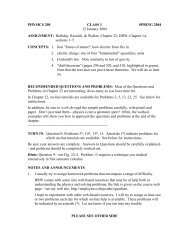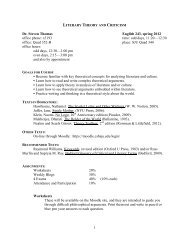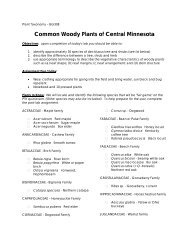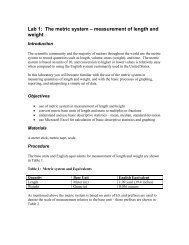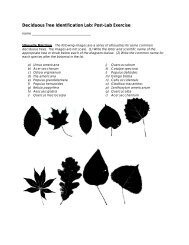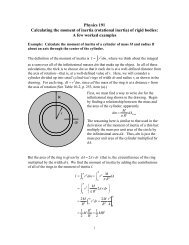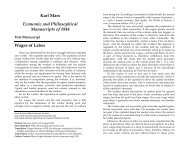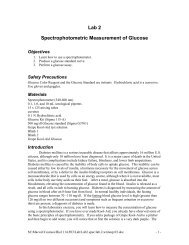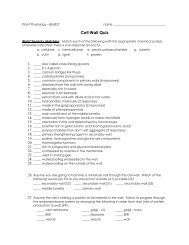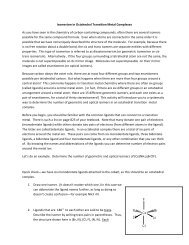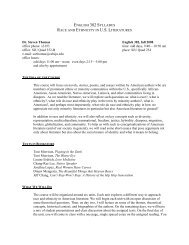Surface-to-Volume Ratios in Plants - Employees Csbsju
Surface-to-Volume Ratios in Plants - Employees Csbsju
Surface-to-Volume Ratios in Plants - Employees Csbsju
- No tags were found...
You also want an ePaper? Increase the reach of your titles
YUMPU automatically turns print PDFs into web optimized ePapers that Google loves.
Table 1. <strong>Volume</strong>, surface area and surface-<strong>to</strong>-volumeratio of a series of cubes of vary<strong>in</strong>g sizesLength of a <strong>Surface</strong> <strong>Volume</strong> S/Vside (cm) Area (cm 2 ) (cm 3 )12345678910Analysis:1. Consider any two cubes; for example, let’s use the ones that are 1 and 3 cm on a side.a. The 3 cm cube is ______ x larger than the smaller one.b. The surface area of the 3 cm cube is _____x larger than the smaller one. Thisvalue is: 2 times greater than the smaller one / the square of the difference <strong>in</strong> sizeof the cubes / the cube of the difference <strong>in</strong> size.c. The volume of the 3 cube is _____x larger than the smaller one. This value is(circle): 3 times greater than the smaller one / the square of the difference <strong>in</strong> sizeof the cubes / the cube of the difference <strong>in</strong> size.2. Offer a brief explanation why the surface/volume ratio decreases as an object getslarger.3. Consider the movie, “Honey, I Shrunk the Kids” <strong>in</strong> which Wayne, a brilliant but klutzyscientist accidentally shr<strong>in</strong>ks his kids <strong>to</strong> about an <strong>in</strong>ch tall. If his daughter was <strong>in</strong>itially 4foot tall and weighed 75 pounds, how much did she presumably weigh after be<strong>in</strong>gshrunk <strong>to</strong> one <strong>in</strong>ch?4. Did you see the classic Grade B horror movie, “The Attack of the 60 foot Woman?” Howmuch would this woman weigh? Assume an ‘average’ woman who is 5 foot tallweighs 110 pounds.
5. Accord<strong>in</strong>g the Gu<strong>in</strong>ness Book of World Records the tallest liv<strong>in</strong>g human female is 7 feet 7¼ <strong>in</strong>ches tall. Us<strong>in</strong>g our assumption that a 5 foot woman weighs 100 pounds, howmuch do you predict this woman weighs? __________. (note: her actual weight = 462pounds)Exercise 2. S/V <strong>Ratios</strong> In Flattened ObjectsIn this exercise we will explore how flatten<strong>in</strong>g an object impacts the surface <strong>to</strong> volumeratio. Consider a cube made out of clay that is 8 x 8 x 8 cm on a side. Then, imag<strong>in</strong>e that wecan flatten this cube mak<strong>in</strong>g it th<strong>in</strong>ner and th<strong>in</strong>ner while ma<strong>in</strong>ta<strong>in</strong><strong>in</strong>g the orig<strong>in</strong>al volume. Whatwill happen <strong>to</strong> the surface area and s/v ratio as the cube is flattened? Let’s make a hypothesis:Method:Hypothesis 2.1: As the cube is flattened, the s/v ratio will (select one: <strong>in</strong>crease / decrease/ rema<strong>in</strong> the same).1. Complete Table 2. To calculate the volume of a rectangular box, multiply length bywidth by height. To calculate the surface area, you need <strong>to</strong> calculate the surface areaof each side and then add these values <strong>to</strong>gether.Table 2. Effect of flatten<strong>in</strong>g a box on surface/volume ratioBox No. Height(cm)Length(cm)Width(cm)volume(cm 3 )1 8 8 82 4 16 83 2 16 164 1 32 165 0.5 32 32<strong>Surface</strong>area(cm 2 )S/V ratioExercise 3. S/V <strong>Ratios</strong> <strong>in</strong> Elongated ObjectsIn this exercise we will explore how elongat<strong>in</strong>g an object impacts the surface <strong>to</strong> volumeratio. Once aga<strong>in</strong> we’ll start with a cube of clay that is 8 x 8 x 8 cm on a side. Now, imag<strong>in</strong>e thatwe pull on the ends <strong>to</strong> make it longer and longer while ma<strong>in</strong>ta<strong>in</strong><strong>in</strong>g the orig<strong>in</strong>al volume. What willhappen <strong>to</strong> the surface area and s/v ratio as the box is elongated?Method:Hypothesis 3.1: As the cube is elongated the s/v ratio will (select one: <strong>in</strong>crease /decrease / rema<strong>in</strong> the same).1. Complete Table 3.
Table 3. Effect of elongat<strong>in</strong>g a box on surface/volume ratioBox No. Height(cm)Length(cm)Width(cm)volume(cm 3 )1 8 8 82 16 4 83 32 4 44 64 2 45 128 2 2<strong>Surface</strong>area(cm 2 )S/V ratioExercise 4. Shape and S/V RatioIn this exercise we will explore the impact of shape on surface <strong>to</strong> volume ratios. Considerthree objects – a sphere (or ball), a cube, and a long, sk<strong>in</strong>ny box (or filament) – all of which havethe same volume (1.0 cm). Which object will have the greatest S/V ratio? Which object is <strong>in</strong>contact with a greater portion of its environment? One way <strong>to</strong> answer the latter question is <strong>to</strong>calculate the amount or volume of the environment that is with<strong>in</strong> 1.0 cm of the object. This isimportant s<strong>in</strong>ce all organisms/structures exchange materials with their environment and theexchange occurs between the organism and the environment directly <strong>in</strong> contact with theobject.Method:Hypothesis 4.1. The shape with the largest S/V ratio will be the (select one: cube / sphere/ filament)Hypothesis 4.2. The shape that is exposed <strong>to</strong> the greatest amount of its environment isthe (select one: cube / sphere / filament)1. Calculate the volume, surface area and S/V ratio for each of three different-shapedobjects <strong>in</strong> Table 4.2. To calculate the volume of environment with<strong>in</strong> 1.0 cm of each object, imag<strong>in</strong>e that theobject is surrounded by a larger object that is 1.0 cm larger on all sides. Calculate thevolume of this larger object and then subtract the volume of the smaller shape.Table 4. Effect of shape on surface-<strong>to</strong>-volume ratiosShapeDimensions(cm)<strong>Volume</strong>(cm 3 )Sphere 1.2 diameter 1.0Cube 1 x 1 x1 1.0Filament 0.1 x 0.1 x 100 1.0<strong>Surface</strong>Area(cm 2 )S/V ratio<strong>Volume</strong> ofenvironmentwith<strong>in</strong> 1.0 cmAnalysis:1. On a separate sheet of paper (preferably graph paper), make a sketch, <strong>to</strong> scale, of thethree objects (sphere, cube, filament).
Exercise 6: Water loss and S/V ratiosWater availability has been a major fac<strong>to</strong>r direct<strong>in</strong>g the evolution of leaf shape <strong>in</strong> plants.We’ve hypothesized that a larger S/V ratio will result <strong>in</strong> greater water loss. In this exercise we willtest this hypothesis by us<strong>in</strong>g sponges that will serve as a model leaf. You will be given a largesponge and a smaller sponge <strong>to</strong> serve as models of plant leaves.Method:Hypothesis 6.1. In a given period of time, the greatest <strong>to</strong>tal amount of water will be lostfrom the (large sponge / small sponge / both sponges will loose an equal amount ofwater).Hypothesis 6. 2. In a given period of time, the sponge that will loose the greatestpercentage of its <strong>in</strong>itial water content is the (large sponge / small sponge / both spongeswill loose an equal amount of water).Hypothesis 6.3. Per unit surface area, the sponge that will loose the greatest amount ofwater is the: (large sponge / small sponge / both sponges will loose an equal amount ofwater).2. Measure the size of each sponge and then calculate SA, volume and S/V ratio.Complete the appropriate rows <strong>in</strong> Table 6.3. Soak the sponge and then squeeze out the excess.4. Weigh sponge.5. Allow the sponge <strong>to</strong> sit on a rack for about an hour. Then reweigh.6. Complete the calculations <strong>in</strong> Table 6.Table 6. Water loss from leaf modelslarge spongelength (cm)width (cm)height (cm)SA (cm 2 )vol (cm 3 )S/VInitial weight sponge(g)F<strong>in</strong>al weight sponge,after evaporation (g)Amount of water lost (g= mL)Water loss per unitvolume (g / cm 3 )Water loss per unitsurface area (g / cm 2 )small sponge1. Expla<strong>in</strong> why plants <strong>in</strong> a ra<strong>in</strong> forest typically have large, th<strong>in</strong> leaves, while cacti have noleaves at all.
2. An orchid specimen is available <strong>to</strong> look at. This plant lives <strong>in</strong> as an epiphyte <strong>in</strong> a ra<strong>in</strong>forest. Expla<strong>in</strong> why its leaves are thick and leathery.Exercise 7. Why Are Cells Small?The typical eukaryotic cell is rather small, approximately 100 μm <strong>in</strong> diameter. With a fewexceptions, the cells of all organisms are about this size. Thus, the reason that an elephant isbigger than a mouse, or a redwood is bigger than a dandelion, is because redwoods andelephants they have more cells, not larger ones. So, why are the cells so small?In this exercise we will use a cyl<strong>in</strong>der of agar <strong>to</strong> serve as a model cell. The agar has anacid-sensitive dye called bromocresol green <strong>in</strong>corporated <strong>in</strong><strong>to</strong> it. The dye turns from blue <strong>to</strong>yellow (clear) <strong>in</strong> the presence of acid. To simulate the cell feed<strong>in</strong>g or obta<strong>in</strong><strong>in</strong>g a critical nutrientfrom its environment, we will place the agar cyl<strong>in</strong>der <strong>in</strong> a conta<strong>in</strong>er of v<strong>in</strong>egar and moni<strong>to</strong>r thecolor of the cyl<strong>in</strong>der. The uptake of acid, and hence colorless areas of the cell model, willrepresent the uptake of food/nutrients by the cell. From this, we can calculate the percent ofeach cell that was fed dur<strong>in</strong>g the <strong>in</strong>cubation period.Hypothesis 7.1: The cell model <strong>in</strong> which the greatest percentage of its volume will get fedis the (select one: small / large) one.Hypothesis 7.2: The cell model <strong>in</strong> the greatest danger of starv<strong>in</strong>g is the (select one: small/ large) one.Methods:1. Obta<strong>in</strong> 2 agar cyl<strong>in</strong>ders (cell models), one small and one large. Wear<strong>in</strong>g gloves,measure the length (height) and diameter of each cell and record your data <strong>in</strong> Table 7.2. Us<strong>in</strong>g a plastic spoon, carefully place each cyl<strong>in</strong>der <strong>in</strong> a conta<strong>in</strong>er conta<strong>in</strong><strong>in</strong>g v<strong>in</strong>egar(be careful).3. Allow the cyl<strong>in</strong>ders <strong>to</strong> sit <strong>in</strong> the v<strong>in</strong>egar for a few m<strong>in</strong>utes until most of the blue color isgone from the smallest cyl<strong>in</strong>der. Then, remove both models with the plastic spoon andplace them on a piece of paper <strong>to</strong>wel.4. Measure the height and diameter of the colored areas rema<strong>in</strong><strong>in</strong>g <strong>in</strong> each model.Record these data <strong>in</strong> table 5.5. Complete the calculations.
Exercise 9. Biological Applications of S/VAlthough these exercises are relatively simple, they provide the basis <strong>to</strong> expla<strong>in</strong> manybiological observations. Listed below are a just a few questions that can be answered us<strong>in</strong>g S/Vreason<strong>in</strong>g.1. Expla<strong>in</strong> why small animals have a higher metabolic rate than large animals.2. Expla<strong>in</strong> why shrews are voracious feeders.3. Expla<strong>in</strong> why cats can fall off tall build<strong>in</strong>gs and survive. Why do people splat?4. Expla<strong>in</strong> the advantages/disadvantages of block vs. cube ice.5. Describe the scientific <strong>in</strong>accuracy <strong>in</strong> the episode of Goldilocks and the porridge.6. Medieval churches were often built <strong>in</strong> the shape of a crucifix. Expla<strong>in</strong> why.7. The earth is geologically active (has a molten core) but the moon is apparently no longergeologically active. Expla<strong>in</strong> why us<strong>in</strong>g S/V ratios.8. Expla<strong>in</strong> why the cells of the spongy layer of a plant leaf are irregularly shaped.References:• Barrett, D. 1983. Body size and temperature: an extended approach. J. Biol. Educ. 71:78.• Cohen, A, AB Moreh, R Chayoth. 1999. Hands-on Method for Teach<strong>in</strong>g the Concept ofthe Ratio Between <strong>Surface</strong> Area & <strong>Volume</strong>. The American Biology Teacher 61: 691 - 696.• Diamond, Jared. 1989. How cats survive falls from New York skyscrapers. Natural His<strong>to</strong>ry,August, pp 20 - 26.• Haldane, J.B.S. On Be<strong>in</strong>g the Right Size.• Gould, S. 1977. Size and shape. In Ever S<strong>in</strong>ce Darw<strong>in</strong>. Nor<strong>to</strong>n, NY.• Moog, F. (1949) Gulliver was a bad biologist. Scientific American 18(5): 52 - 56(November)• Stanek, Jr., J. A. (1983) Why don't cells grow larger? American Biology Teacher 45:393-395.• Flannery, M (1986) Why is size so important? American Biology Teacher 51: 122 - 125.• Morowitz, H (19 ) Of mammals great and small. In The W<strong>in</strong>e of Life. St. Mart<strong>in</strong>'s Press.• Went, FW (1968) The size of man. Scientific American 56: 400 - 413.• Built <strong>to</strong> scale. (1999) Science News 156: 249 - 251.Useful Equations:Useful EquationsShape Equation for <strong>Volume</strong> Equation for <strong>Surface</strong> Areacube L x W x H L x W x 6box(filament)L x W x Hdeterm<strong>in</strong>e SA for each sidethen addsphere 4/3 (π) r 3 = 4.189 r 3 4 (π) r 2 = 12.57 r 2cyl<strong>in</strong>der π r 2 H 2 π r 2 + 2 π r H = 2 π r (r + H)circle π r 2square orrectangleL x W



